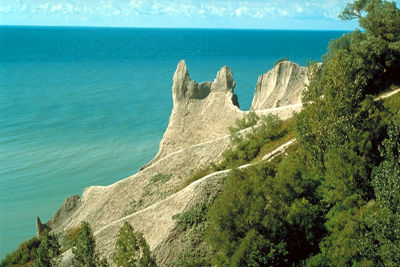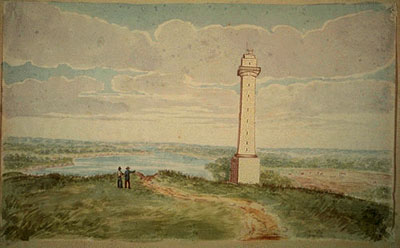
Geology and Erosion
The falls have eroded the soft shales and limestones of the escarpment at an average rate of 1.2 m per year and now stand 11 km from their place of origin at present-day Queenston. Their recession rate has been variable though, as the volume of water flowing from the upper Great Lakes controls it. Because of changing land and lake levels in northern Ontario, the flow through the Niagara River was reduced to 10 per cent of its present volume for a period of 5,000 years. During this time the falls were almost stationary.
Indigenous Peoples
Niagara Falls were of spiritual significance to Indigenous peoples, such as the Iroquoian-speaking Neutral. The Neutral lived throughout the Niagara Peninsula, between the Grand and Niagara rivers. They were called Neutral by the French, who observed that the tribe remained neutral in most conflicts between the Wendat (Huron) and the Haudenosaunee. During the Iroquois Wars of the middle and late 17th century, fought in part over control of the fur trade, the Haudenosaunee depopulated and dispersed the Neutral.
Niagara is derived from an Indigenous word, likely from within the Iroquoian language family (see Indigenous Languages in Canada). However, its exact origins and meaning are unknown. There are two common interpretations. First, that it means “thundering waters,” referring to Niagara Falls. Second, that it means “neck,” referring to the way in which the Niagara River connects lakes Erie and Ontario.
European Settlement and Tourism
Missionary Louis Hennepin, who saw the falls in 1678, was the first European to describe them. He called the spectacle “a vast and prodigious Cadence of Water.” Among those who tried to describe their effect was Charles Dickens, who wrote, “I seemed to be lifted from the earth and to be looking into Heaven.” With tourism, which began in the 1800s, came daredevils who defied the falls in barrels, boats and rubber balls. The most celebrated was The Great Blondin, who in 1859 performed on a tightrope over the gorge. Stunting was outlawed in 1912.
To save the area from hucksters and speculators, Ontario created Queen Victoria Park in 1885 — Canada’s first provincial park. That same year a similar public park was created on the American bank. Millions of tourists visit the area every year, viewing the falls from several towers, a tunnel beneath Horseshoe Falls, a cable aerocar over the whirlpool, a jet boat through the lower rapids and the Maid of the Mist, a boat that carries sightseers to the foot of the falls.
Hydroelectricity
International agreements control the diversion of water for hydroelectric power, which was first generated on the Canadian side of the river in 1893. The Niagara Diversion Treaty (1950) stipulated that a minimum flow of 50 per cent be reserved for the falls during daylight hours in the summer and that the rest, up to 75 per cent overnight and during the winter, be divided equally between Canada and the US. In Canada water is diverted from the Niagara River above the falls and fed into the turbines of Sir Adam Beck Generating Stations No. 1 and No, 2 by canals and tunnels, after which the water is returned to the river.

 Share on Facebook
Share on Facebook Share on X
Share on X Share by Email
Share by Email Share on Google Classroom
Share on Google Classroom







